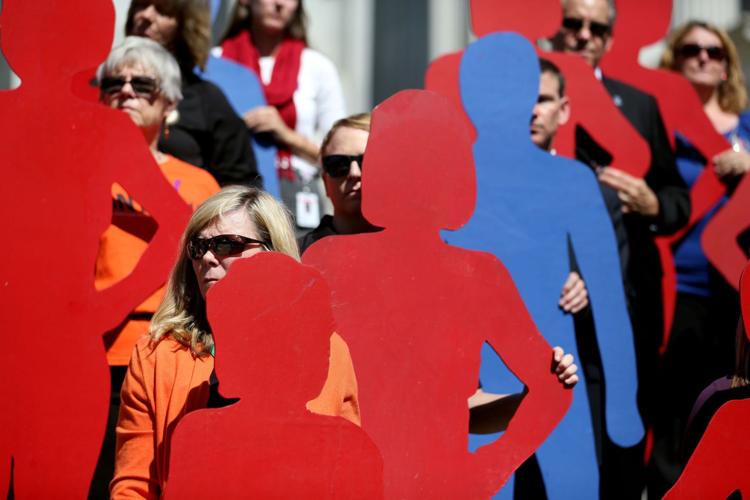BERKELEY COUNTY — A 30-year-old woman’s husband hunted her down, forced her car off the road and shot her six times before leaving her bleeding to death on the side of the road, police records say.
It was the last time law enforcement responded to a call about the husband's violence. But it wasn't the first.
The alleged shooter, Salin Mojica Hernandez, is set to stand trial this week in Berkeley County General Sessions Court. The case sits against a backdrop of long-term and widespread domestic violence in South Carolina.
The victim in Hernandez's case, Maria De La Cruz Chavarria, is one of three domestic homicides in Berkeley County in 2021, and one of 40 such killings in South Carolina that year.
The Palmetto State has ranked in the top 10 most dangerous states for women in all but two of the past 25 years that the Violence Policy Center has published its ‘When Men Murder Women’ study based on FBI data.
The yearly report whose findings have led to the passage of laws that protect women and children from domestic violence is released each October during National Domestic Violence Awareness Month.
Its most recent report, which analyzed data from the past quarter century, found that more than 25,000 women were murdered by men in incidents involving one offender and one victim.
The majority of those women, 92 percent, knew the men that murdered them, and two-thirds were intimate partners with their killers.
“It’s a terrible picture,” said Sara Barber, the executive director of the South Carolina Coalition Against Domestic Violence and Sexual Assault.
Domestic violence persists nationwide
The Violence Policy Center’s study, based on data from the FBI’s Supplementary Homicide Reports, ranks the states by their rates of females killed by males and gives details about the circumstance of the crimes and demographics of the victims.
It found that 64 percent of the women murdered by men were White, and 31 percent were Black. Murder rates climbed among Black and American Indian females, compared to other races.
In 2020, Black women only accounted for 14 percent of the U.S. population, but they accounted for twice as many murders. They were killed at a rate of nearly three times what White women faced.
And more than half of all victims were killed with a firearm, like Marie De La Cruz Chavarria.
“Guns can easily escalate domestic violence to domestic homicide,” the study said. “(Guns increase) a woman’s risk of being a victim by five times.”
This comes as the U.S. Supreme Court agreed this summer to hear a case that could allow domestic violence defendants to legally have guns.
“In this country, sometimes access to guns is more valued than people are,” Barber said. “We shouldn’t be surprised when the outcome of that is extraordinary high levels of violence.”
States in the South and Southwest that tend to have higher levels of firearm ownership were among the states that consistently had the highest rates of domestic homicide.
The only state that ranked in the top 10 states for women killed by men more often than South Carolina was Louisiana, the study found.
Still a South Carolinian problem
While the Palmetto State has improved since this study ranked it the worst in the country in 2013 — prompting the Post and Courier’s Pulitzer Prize-winning "Till death do us part" series about domestic violence and ensuing changes to state law — there’s still work to be done, experts say.
Even as penalties for domestic violence have been increased and stipulations prohibiting guns were added, domestic violence cost the state nearly $360 million in 2020, a study from the Jamie Kimble Foundation for Courage found.
These costs came from physical and mental health care, court costs, policing and prisons, lost productivity at work and other factors stemming from domestic violence.
“It’s appalling,” Barber said.
And cases like Marie De La Cruz Chavarria, the 28-year-old woman whose husband is expected to stand trial, aren’t misnomers in the Charleston area.
More than 60 percent of women in the Lowcountry have experienced domestic abuse, according to the preliminary results of a new Lowcountry study by the Medical University of South Carolina and My Sister’s House.

Jamacia McCray and Lakeisha Roach hold up signs to remind people that October is Domestic Violence Awareness Month at the H. Odell Weeks Activity Center in Aiken. South Carolina consistently ranks as one of worst states for domestic violence. File/Matthew Christian/Aiken Standard
“This is an epidemic, and it is touching everyone in this community,” Tosha Connors, CEO of My Sister’s House, said during a recent press conference that The Post and Courier previously reported on. “No one is immune to domestic violence.”
The South Carolina Coalition Against Domestic Violence and Sexual Assault wants to focus more energy on preventing these crimes before they occur.
And these incidents begin happening early. Nearly one in 10 female high school students across the country reported abuse from an intimate partner, according to the CDC’s Youth Risk Behavior Survey based on data from 2021.
One way parents can play a part in prevention efforts is talking to their children about healthy relationships, including rules of consent and how to stand up for others, Barber said.
“Domestic violence is impacting someone we know,” Barber said. “It could be a child, a colleague, your friend, a family member — it’s somebody we know. And all of us can do something to support them.”
Resources for victims of domestic violence can be found here.
Editor's note ... The spelling of the victim's name and her age has been corrected in this story.







